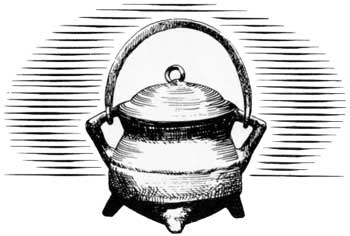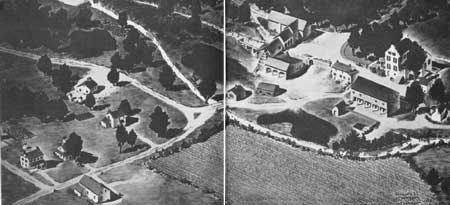|
HOPEWELL VILLAGE National Historic Site |
 |

Hopewell Furnace, 1887, four years after the last blast.
HOPEWELL VILLAGE, in colonial times, was built around a cold-blast, charcoal-burning iron furnace and associated structures. The community life was in some respects similar to that of the small feudal manors of medieval Europe and was largely self-sustaining. This condition prevailed at Hopewell, little changed, beyond the colonial period, through most of the nineteenth century. The furnace was closed down permanently in 1883, after 113 years of activity. The quiet of abandonment gradually settled over the place, and it became a ghost community of another era. Even though abandoned, except for limited farm purposes, the quaint little group of early industrial structures and the surrounding picturesque houses were preserved because of the isolated nature of the site in the hills back of the Schuylkill River. The restless hand of modern progress scarcely reached this little vale in the lovely forest-covered hills.

Hopewell Village tells the story not of a single historical event, but rather of a broad sweep of American growth and productive effort. This story—from the first attempt at iron making in the New World, through the days of '76 when an already thriving industry was able to play its part for independence, down to recent times—is an inseparable part of the American saga.
Here is an authentic display of social, cultural, industrial, and economic environment of life in an iron-making community of colonial and early America. Hopewell Village will afford for the present and future generations a picture of the humble but ingenious beginnings in out country of this basic industrial enterprise and will provide a striking contrast for measuring the growth and magnitude of the modem American iron and steel industry.

Artist's conception of Hopewell Village during
its active days.
Drawing by Kenneth W. Thompson.
Establishment of the Early American Iron
Industry
Columbus, seeking wealth in precious metals, as well as a route or passage to Asia, found that none of the natives he met was acquainted with the use of "iron, steel or firearms." There was a good reason for this. Gold, silver, copper, and lead often occurred in a "free" state, almost pure, and in sufficient quantity for satisfying the practical needs of even such highly developed Indian civilizations as those of the Aztecs and Incas. Iron ore on the other hand, was hardly ever obtainable, except in combination with oxygen, sulfur, phosphorous, or silica; and its isolation from these "impurities" for the purpose of making iron objects involved a comparatively difficult process. Hence, it remained for the white man to develop iron manufacturing in the Western Hemisphere.
During the first attempts of the English to establish American colonies, an expedition sent out by Sir Walter Raleigh, in 1585, found iron ore in North Carolina. The news, together with the fact that an "infinite store of wood" for charcoal was available, prompted Thomas Hariot, historian of the expedition, to suggest the establishment of ironworks in the new colony. For England's dwindling forests and the increasing cost of wood, coupled with the needs of the Navy, posed a serious problem to English ironmasters. But the first attempt at iron making in America was not made until 1621, at Falling Creek, Va., 66 miles north of Jamestown. It was an ill-fated attempt, for in the following year Indians swooped down on the tiny settlement, killing the ironmaster and his men and destroying the works.
Not until the 1640's were any successful ironworks established. These were in the Massachusetts Bay settlements, where under the leadership of John Winthrop, Jr., son of the Governor, a "Company of Undertakers for the Iron Works" was formed. This company, incorporated by the General Court in 1644, obtained a monopoly to make iron in the colony for 21 years. Capital was secured, skilled workmen were brought from England, and furnaces and forges were built at Lynn, on the Saugus River, and at Braintree, about 10 miles south of Boston. Quantities of excellent iron were smelted, cast, and forged from the bog ores of Massachusetts at both of these works during the next half century.
From Massachusetts, the infant industry spread into the neighboring colonies of Plymouth, Connecticut, and Rhode Island. In 1654, Roger Williams attempted to promote an enterprise at Providence. Soon afterwards, Joseph Jenks, who made the dies for the famous pine tree shillings, built a bloomery at Pawtucket. It operated successfully until 1675 when the Narragansett Indians destroyed it during the Wampanoag War. By the beginning of the eighteenth century the iron industry in New England had taken firm root so much so that already English manufacturers were complaining to Parliament of competition from the New World.

|
|
Last Modified: Mon, Dec 2 2002 10:00:00 am PDT |


